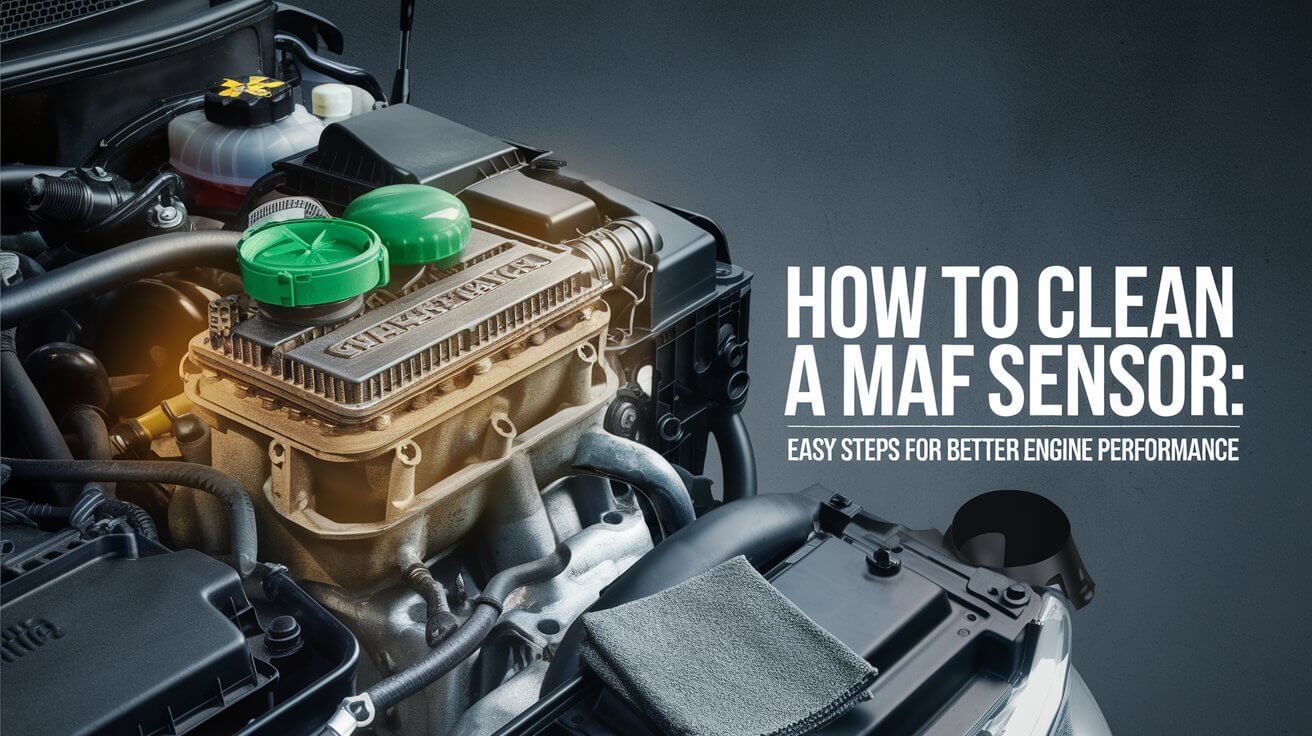How to Clean a MAF Sensor: Easy Steps for Better Engine Performance

The Mass Air Flow (MAF) sensor is crucial to your vehicle’s performance, ensuring the engine receives the right amount of air for combustion. Over time, dirt and debris can accumulate on the MAF sensor, leading to poor engine performance, such as rough idling, poor fuel efficiency, and even the dreaded “Check Engine” light. Regular cleaning of the MAF sensor helps keep your engine running smoothly and efficiently.
In this guide, we’ll cover how to clean a MAF sensor, when and why to clean it, the symptoms of a dirty sensor, and step-by-step instructions on cleaning it without damaging this delicate component.
What Is a MAF Sensor and Why Does It Get Dirty?
What is the Mass Air Flow (MAF) Sensor?
The MAF sensor measures the amount of air entering your engine and sends this data to the car’s Engine Control Unit (ECU). The ECU uses this information to calculate the appropriate amount of fuel for optimal combustion. A well-functioning MAF sensor helps maintain a balanced air-fuel ratio, improving your car’s performance, fuel economy, and reducing emissions.
Why Does the MAF Sensor Need Cleaning?
Over time, the MAF sensor can become coated with dust, dirt, and oil from the air intake, particularly if you have a reusable air filter with oil on it. This debris interferes with the sensor’s ability to measure airflow accurately. As a result, the ECU receives incorrect data, leading to engine performance issues such as reduced fuel efficiency, increased emissions, and power loss. Cleaning the sensor regularly is a simple task that can prevent more serious and costly repairs down the road.
Signs Your MAF Sensor Needs Cleaning
Common Symptoms of a Dirty MAF Sensor
A dirty or faulty MAF sensor can cause several issues that impact your driving experience. Here are some common signs that your MAF sensor may need cleaning:
- Check Engine Light: One of the most common indicators of a dirty or malfunctioning MAF sensor is the appearance of the check engine light. The ECU may detect irregularities in the air-fuel ratio, triggering the warning.
- Poor Fuel Economy: If your MAF sensor is sending inaccurate data to the ECU, your engine might overcompensate by using more fuel than necessary. You’ll notice a drop in fuel efficiency as a result.
- Erratic Idling: A dirty MAF sensor can disrupt airflow, causing the engine to idle unevenly or fluctuate unexpectedly. This can make your car feel like it’s “stumbling” at idle.
- Hard Starts: The right air-to-fuel ratio is crucial for smooth engine starts. If the sensor is dirty, it may prevent the engine from starting easily.
If you notice any of these symptoms, it’s a good idea to check and clean the MAF sensor before the problem worsens.
Tools and Materials You Need to Clean a MAF Sensor
Before you start cleaning your MAF sensor, gather the following tools and materials:
- MAF Sensor Cleaner: This is the most important tool for the job. MAF sensor cleaner is specially designed to clean the sensor without leaving any residue. Never use brake cleaner, carburetor cleaner, or any other cleaner, as these can damage the sensor.
- Screwdrivers: You’ll need these to remove the clamps or screws securing the sensor to the air ducts.
- Microfiber Cloth (Optional): You can use this to wipe the surrounding area after removing the sensor, but avoid touching the delicate sensor wire with it.
- Latex or Nitrile Gloves: Wearing gloves will help keep your hands clean and prevent oils from your skin from contaminating the sensor.
Step-by-Step Guide to Cleaning a MAF Sensor
Step 1: Locate the MAF Sensor in Your Vehicle
The MAF sensor is usually located between the air filter and the throttle body. To find it:
- Open your vehicle’s hood and locate the air intake system. This is a large plastic duct that runs from the air filter box to the engine.
- The MAF sensor is mounted directly on the air intake duct, between the air filter and the throttle body. It’s a small rectangular part with an electrical connector attached to it.
If you’re having trouble locating the MAF sensor, consult your vehicle’s owner manual for the exact location.
Step 2: Remove the MAF Sensor
- Turn off the engine and allow it to cool down before working on it.
- Disconnect the electrical connector by pulling it gently, making sure not to damage the wires.
- Use a screwdriver to loosen the clamps or screws holding the sensor in place. Be careful, as the plastic components can become brittle over time and are easy to break.
- Gently remove the sensor from the air intake duct. If it’s stuck, use a small tool like a flathead screwdriver to carefully loosen it without applying too much force.
Step 3: Clean the MAF Sensor
- Take the MAF sensor away from the engine to a well-ventilated area.
- Spray the sensor with MAF sensor cleaner. Apply 10-15 bursts of the cleaner directly onto the sensor’s wire or plate (depending on the sensor type). Avoid touching the sensor with your fingers or any objects, as it is extremely delicate.
- If your sensor has an inlet screen, clean it with the cleaner as well. Do not use brushes or cloths, as this can damage the sensitive components.
- Let the sensor air-dry completely for at least 10-15 minutes. Do not attempt to dry it with compressed air or cloth.
Step 4: Reinstall the MAF Sensor
Once the sensor is fully dry, it’s time to reinstall it:
- Slide the MAF sensor back into place in the air intake duct.
- Reconnect the electrical connector and make sure it’s securely fastened.
- Tighten any screws or clamps to secure the sensor in its original position.
- Close the air filter box and secure it as well.
- Finally, start your engine and check to see if it’s running smoothly. If you had a check engine light on, it may turn off after a few minutes of driving.
Alternative Cleaning Methods
Cleaning the MAF Sensor With Alcohol
In cases where MAF sensor cleaner isn’t available, isopropyl alcohol can be used as an alternative. To clean with alcohol:
- Dampen a soft cloth or cotton swab with alcohol.
- Gently clean the sensor wire or plate.
- Allow the sensor to dry completely before reinstalling.
Note: While this method can work in a pinch, it is not as effective or safe as using a dedicated MAF sensor cleaner.
Can You Clean a MAF Sensor Without a Cleaner?
If you don’t have access to any cleaning solutions, some people suggest using a small metal filament, like a bobby pin, to carefully scrape off dirt. However, this method is risky and can easily damage the sensor. It is not recommended unless you have no other options.
FAQs About MAF Sensor Cleaning
How Often Should You Clean Your MAF Sensor?
The frequency of MAF sensor cleaning depends on your driving conditions and the type of air filter you use. A good rule of thumb is to clean the MAF sensor every time you change your air filter. If you use a reusable oiled air filter, you may need to clean the sensor more frequently, as these filters can leave an oily residue on the sensor over time.
What Happens if You Don’t Clean a Dirty MAF Sensor?
Failing to clean a dirty MAF sensor can lead to a host of engine problems, including poor fuel economy, loss of power, rough idling, and increased emissions. If left unchecked, a dirty sensor can eventually cause damage that requires replacement rather than cleaning.
Should You Replace or Clean the MAF Sensor?
Cleaning the MAF sensor should be your first step when you encounter issues like rough idling or poor fuel economy. However, if cleaning doesn’t resolve the issue, or if the sensor appears damaged, it may need to be replaced. Replacing the sensor is more expensive than cleaning but may be necessary if the sensor is faulty.
What’s the Cost of a New MAF Sensor vs. Cleaning?
A new MAF sensor can range from $100 to $400 depending on the make and model of your vehicle. In contrast, a can of MAF sensor cleaner costs around $10 to $20. Given the cost difference, cleaning the sensor regularly can save you significant money over time.
Conclusion
Cleaning your MAF sensor is a simple but vital maintenance task that can greatly improve your vehicle’s performance. By ensuring accurate air-fuel ratio readings, a clean MAF sensor helps your engine run smoothly, improves fuel efficiency, and prevents costly repairs. With just a few tools and some dedicated MAF sensor cleaner, you can keep your engine in top shape without breaking the bank.
Make cleaning your MAF sensor part of your regular maintenance routine and enjoy better fuel efficiency, smoother idling, and overall improved performance.


